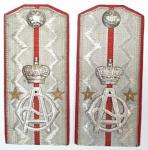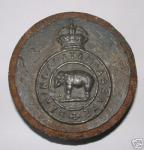
REGAL UNIFORMA COLECTOR
For Deletion-
Posts
135 -
Joined
-
Last visited
Content Type
Profiles
Forums
Blogs
Gallery
Events
Store
Everything posted by REGAL UNIFORMA COLECTOR
-
Thanks Terry, Useful information. So what you are saying is that heavier metal badges with the back side in a dark brownish red hugh color which was considered original are now being faked as well ? What about manufacture markings ? Post stamped "J. R. Gaunt , London" for example. Are markings being faked as well ?
-
Terry, I understand about some of the design changes and crowns from different periods. What I have noticed but cannot pin down without complete certainty is that WW1 badges were made of thicker metal. The nickel plating was thicker, and the reverse side of the badge metal discoloration from being heat treated is different in color and darker then what you see of badges made in WW2. Would this be an accurate statement ? Or would these guidelines be difficult to date due to the badges being all different depending upon which manufacture had made them.
-
To understand what is a so called re-strike or a high quality made fake, one must first understand how badges were made during the period of late 1800's-WW1. I beleive that badges were made by inserting a metal brass sheet and stamping them between two dies. Male and Female dies. This forced the design into the metal. Unlike Imperial Russian badges which were shear cut at the same time leaving shear lines to the outer edges of the badge, british badges are smooth and do not have shear lines. How were the edges cut and the outer edges cleaned up ? Was the same stamping process used in WW2 to make badges ? Photo of a male die. (Source : Ebay) [attachmentid=53086]
-
If re-strikes are nothing more then an almost perfect fake, can some of you enlighten us on how to tell a genuine badge from a so-called re-strike ? I have a handful a WW1 cap badges. Heavy and thicker brass or bronze badges with some portions of the badge nickel plated. The reverse side is darkened flat colored metal from being heat treated to increase strength. The flat tab is attached by braising and not soldered. But...No wear and tear. I'm confused. Mint WW1 originals or high quality fakes ?
-
Re : Re-strikes. I often see on ebay honest sellers who say that their badge is a re-strike from the original dies and aged to look old. Looking at the photos, how can one tell ? They look the same as the original badges. What are the characteristics to look for ? If anyone has any photos to add showing examples of original badges next to a re-strike and can explain to us what to look for, this would be appreciated
-
Hello fellow badge collectors, Please use this forum topic to help educate us beginners on spotting and identifying the many fakes, reproductions and re-strike badges that are out there. Show us your photos and help us learn how to identify the different characteristics that make these badges reproductions, fakes and re-strikes.
-
Imperial Russia Fake Medal
REGAL UNIFORMA COLECTOR replied to REGAL UNIFORMA COLECTOR's topic in Russia: Imperial
Down load the photo and then zoom in on it. You can see pits and excess metal slag. Also you see straight lines caused from sanding and buffing. This medal is cast and made to look old. -
Imperial Russia Fake Medal
REGAL UNIFORMA COLECTOR replied to REGAL UNIFORMA COLECTOR's topic in Russia: Imperial
Reverse side. Mouse click photo to enlarge it. -
Here is an intereting and rare medal for sale on Ebay. At first glance, it looks good. Then you notice the freshly cut ring loop hole. Mouse Click photo to enlarge it.
-
Imperial Russia Imperial Russian officer aglets
REGAL UNIFORMA COLECTOR replied to Theodor's topic in Russia: Imperial
Looks like an enlisted man in the Czar's Cossack escort battalion at Tsarkoe Selo. Circa 1870's.-80's. -
Imperial Russia Imperial Russian officer aglets
REGAL UNIFORMA COLECTOR replied to Theodor's topic in Russia: Imperial
ADC Aide-de-Camp Adjutant Staff Officer pre-1914 in silver wire worn on colored dress uniforms. -
Imperial Russia Enamel comparisons FAKE/Original
REGAL UNIFORMA COLECTOR replied to GeorgeCL's topic in Russia: Imperial
Black enamels in the old days used charcoal for pigmentation. Under a magnifier and strong light, you will see that it has a brown or yellow cast to it. Black enameling today that appear on reproductions are pure black. -
Imperial Russia Enamel comparisons FAKE/Original
REGAL UNIFORMA COLECTOR replied to GeorgeCL's topic in Russia: Imperial
When observing enameling which was done 100 years ago or longer versus what resources are available to the faker today, a collector must understand the application process as well as the colors and pigments that were available both then and now. If you understand this process and know what to look for, fakes will be easy to identify. Let me begin with the enameling process. Majority of orders and badges have a very hard and glassy like enamel on them. This enameling was applied very similar to like Powder Coating of today. It went on ruff, textured and powdery. The colors were not the same when applied. They would change after it was baked which allowed it to flow and become glass like. The jeweler or manufacturer would then use rubbing compound or jewelers rouge to polish the enameling. The fakes of today use enamels as well. But these enamels are in liquid form. "Paint". Like Automotive quality enamels. Paint, if not rubbed out will be lumpy and textured. Again, rubbing compounds or jewelers rouge is required to polish the enameling. It is also easy to spot by applying your finger nail into the enameled surface. Enamels can be applied with and without catalyst hardeners. Without hardener, the enamel is soft and you can leave a fingernail indentation into the surface. With a catalyst hardener, chances are you can do the same thing as it is very difficult to measure the right quantity when mixing for such a small area. Too little or too much hardener also affect the curing of the paint. Color and pigmentation. 100 years ago and older, pigments where made from several organic sources. Plants, minerals, rocks, etc. They where not very clean and bright. They had a very muddy or dirty appearance. Pastel white enamels even had a lot of black specs in it. Imperfections when grinding rock that could not be filtered out. Look at paint on a very old car from the 1920's-1930's. The color is always muddy and dirty looking in pigmentation verses cars made today which are very bright and clean looking. Pigmentation today comes from several sources including mining and synthetic man made. The refining methods make for brighter and cleaner pigments used in ink and paint. These brighter colors also send up red flag warnings to a collector that a badge or order may have been reproduced. Hope this has been some help. -
Imperial Russia IRAS SHOULDER BOARDS
REGAL UNIFORMA COLECTOR replied to REGAL UNIFORMA COLECTOR's topic in Russia: Imperial
They are very rare and highly reproduced. What I like about Pilot shoulder boards are that they usually identify the pilot to an actual corps, division, Army that the pilot was assigned to. Perhaps with that information, we could someday identify the pilots of such boards. -
Imperial Russia IRAS SHOULDER BOARDS
REGAL UNIFORMA COLECTOR replied to REGAL UNIFORMA COLECTOR's topic in Russia: Imperial
I am to assume that this was a czarist made badge as it is in silver with crown and silver back plate. Must be silver hall marked ? In China during the 1920's, badges were made using a process of sand casting and melted down silver coins. This badge pre-dates the photo. Was this badge privately made for civilian attire ? -
Imperial Russia IRAS SHOULDER BOARDS
REGAL UNIFORMA COLECTOR replied to REGAL UNIFORMA COLECTOR's topic in Russia: Imperial
These insignia's where nicknamed by their pilots as the "FLY". Now you know why. -
Imperial Russia IRAS SHOULDER BOARDS
REGAL UNIFORMA COLECTOR replied to REGAL UNIFORMA COLECTOR's topic in Russia: Imperial
Interesting pieces. The 3 small pieces look like they used electricians copper ground wire. Pretty thick stuff. The shoulder board insignia made of brass looks to be a cast copy. Lacks detail. The bronze one above actually looks good. The originals look just like this. Black finish on bronze. They were originally made with the crown which had been snipped off during the provisional days. I do not believe that this badge was made for the provisional government, rather it was modified. If original, you should see some snip marks as to where the crown was and this piece should also be stamped, not cast. You can tell by observing the back side and to look for the shear lines on the edge of the badge indicating that it was forced through a stamping machine. I forget what they called this process. Die-cut ? The silver badge, who knows. never seen one like this. Need to physically observe to comment on it. -
The KGB and High Ranking Soviet officials were the collectors of Russian art and militaria during Communist days. There really was nobody collecting as the stuff was not available on the streets and people did not have the money. Today, we see a lot of Mafia who are collectors. These people have the excess money that make it very tempting for curators to steal. They are the ones with all the money driving up the prices there and abroad. These people are neither historians or true collectors in the sense of the name. It is purely a status symbol as it was in the old days. Presently, the former KGB is closely tied with Mafia which orchestrates most of theses thefts. The reason Putin is making such a stink about this theft over the other 100 or so thefts that occur yearly in Russian Museums both in Russia and abroad is that this particular theft was done by an outsider who had pawn the items on the street. This person was neither ex-KGB or Mafia. Now, it has became bad press. A public relations problem for Putin. If the person where ex-KGB or Mafia who took the items, I bet it would not have been publicized. They seem to take care of there own and as long as they steal for themselves, its never publicized. The theiving would continue as it has been since Gorbachov was in office. Now, this latest theft from someone who is neither ex-KGB or Mafia has publicly exposed the Museum thieving problems making it harder for the REAL THIEVES to operate. Again, I would like to see what treasures are displayed in Putin's house. Understand that corruption is still wide spread in Russia and affects all levels of Government.




